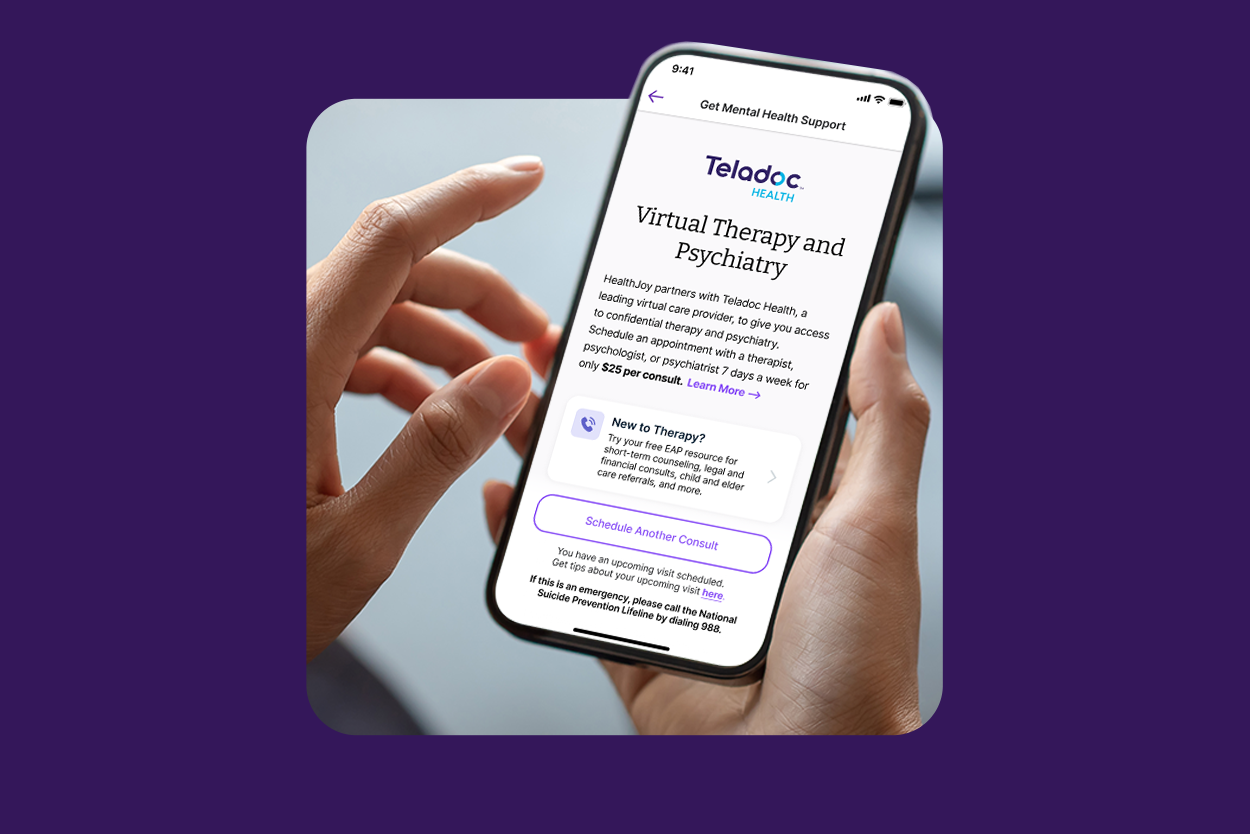HealthJoy Accelerates Your Cost-Containment Strategy
Employer healthcare costs climb every year. For individuals, the stakes are perhaps even higher.
Connected Navigation Platform
Guiding to high-value care
Behavioral Health
Foster a mentally healthy workplace
EAP
Supporting holistic wellbeing
Virtual MSK Care
Reimagining musculoskeletal care
Virtual Primary Care
Powered by smart navigation
Surgery Centers of Excellence
Best-in-class surgical outcomes
Virtual Urgent Care
Immediate care, any hour of the day
Chronic Care
A new approach to chronic care
Integrations
Flexible to any strategy

Reuters predicts that healthcare spending in the United States is set to grow 5.6% per year between now and 2032. This outpaces the growth rate of the United States GDP, which is projected to be 4.3% during the same period.
Since rising healthcare costs seem to be here to stay, it’s more important now than ever for employers to have solutions in place to contain healthcare costs.
Though this factor might seem out of your control, benefits account for around 30% of employer spending — and employers have options.
Here are seven ways you can save on healthcare while helping employees lead healthier, happier lives.
Benefits packages are growing every year, but new solutions to reduce the cost of care are only useful if employees actually use them. When you integrate your benefits into a single, connected care navigation platform, you effortlessly ensure your employees understand, value, and get the most out of your benefits investment.
A healthcare and benefits navigation solution can connect every benefit and point solution in your package. For employees, this creates a one-stop shop for all things benefits including information on point solutions, in-network providers, mental health resources and more affordable care options such as virtual care. All of this can be made easily accessible to employees through a convenient benefits wallet – supported by a combination of AI and automation plus human healthcare concierge guidance. The result? Increased utilization, benefits satisfaction and cost savings.
For employers, connecting your benefits ecosystem through a self-service platform will also reduce the administrative burden on your HR team – freeing them up to work on more pressing initiatives.
It’s crucial for HR professionals to assist and encourage employees as they navigate the healthcare system. HR teams are often stretched thin and communicating with individual employees about their benefits on a consistent basis is challenging.
Benefits programs are often underutilized because members don’t truly know how to use them or when to use them. Blanket communications aren’t timely or personalized enough to affect member behavior. A centralized care navigation platform takes on the burden of benefits communications and engages members year-round, so you never have to lift a finger.
Customized outreach is simple with a benefits broadcaster tool built into the platform, so you can quickly and easily send custom push notifications and in-app messages straight to your employees’ phones. Keep them up-to-date on open enrollment, announce changes in benefits, highlight underused perks and more. You can (and should) provide employees with benefits information and educational resources throughout the year, not just during open enrollment. In fact, SHRM reports that 68% of Gen Z employees want their employer to communicate with them about their benefits after they enroll.
Healthcare navigation platforms leverage data to engage members with appropriate interventions that address their specific health needs. This process is called automated digital steerage.
Steerage directs employees to virtual and on-site care. Depending on your benefit offerings that could mean directing employees to virtual urgent care, prescription discounts, on-site clinics or specialty providers such as fertility solutions or cardiometabolic care. HealthJoy clients regularly save hundreds, and sometimes thousands, per employee per year thanks to digital steerage.
According to the Centers for Disease Control and Prevention (CDC), many chronic conditions, which account for 90% of the US healthcare spend, can be avoided through appropriate preventive care. Employees who don’t understand their benefits often avoid or delay care which can lead to chronic conditions and greater healthcare expenditures later.
A care navigation solution can prompt employees to schedule preventive screenings and annual physicals. These screenings identify health concerns (e.g. high blood pressure) before they get worse. Identifying these concerns early allows patients to partner with a healthcare provider to map out a proactive action plan.
Virtual care allows employees to visit a medical provider for immediate care using a smartphone or tablet, usually within just 15 minutes. This happens without an appointment, travel or time spent in a waiting room. These medical providers are board-certified and can diagnose, treat and even write prescriptions for about 70% of typical medical visits that happen within the US.
The majority of vendors provide service 24 hours a day, seven days a week; perfect for those middle-of-the-night, holiday or weekend visits. Virtual care has been around since the early 2000s. The biggest issue with virtual care until a few years ago was low employee utilization. Now, employees not only utilize these services but they often prefer them. In fact, most employees expect virtual care options to be a part of their benefits offerings and healthcare experience.
A big part of cost containment is educating employees on being better healthcare consumers. It’s no secret that health literacy is a problem in the United States. The healthcare system can be overwhelming to navigate and benefits programs can be confusing. According to the US Department of Health and Human Services, 88% of US adults have less than proficient health literacy. Educating employees on the role they play in the healthcare ecosystem can help build a sense of accountability and empowerment.
Employers also should be promoting transparency tools and bill review services. It’s a little-known fact, but most healthcare services are shoppable, and prices for the same service can vary by up to 500% or more. Encouraging employees to use a price transparency tool can lead to significant cost savings. Additionally, providing a service where employees can submit their medical bills for review can lead to savings for you and your members. Research shows that up to 80% of medical bills contain errors and these mistakes can add up quickly. Many bill review services also can help negotiate on an employee’s behalf and correct billing errors.
Building a personalized benefits experience can maximize engagement and provide members with much-needed guidance and support. But to do this for all members at scale, HR teams need to leverage innovative, digital resources.
Care navigation platforms use your specific health plan data and individual benefits elections to create a more personalized benefits experience for your employees. This allows members to quickly find information about their benefits and best options for care. And when employees can make smart healthcare decisions with ease, healthcare costs go down — for them and your company.
Healthcare is becoming more complex every year, and there isn’t a single solution to solve the problem of rising costs. But building a strong foundation of navigation and support is a smart place to start.
While point solutions can make a meaningful contribution to lowering costs, without a comprehensive solution that helps drive employee engagement in all your programs, they run the risk of falling flat.
HealthJoy makes all benefits – regardless of vendor – feel like a single, connected experience for employees. We give HR teams and their partners a space to supercharge their benefit strategies and better control long-term healthcare spend.
If you’re interested in learning more about how HealthJoy can bring benefits to life, we’d love to talk.

Employer healthcare costs climb every year. For individuals, the stakes are perhaps even higher.

During the pandemic, we heard a lot about the harmful effects of delayed care. Employees who were afraid to see their doctors in person skipped...

If you are responsible for managing employee benefits – phrases like “healthcare costs are skyrocketing” are the soundtrack narrating your work day.